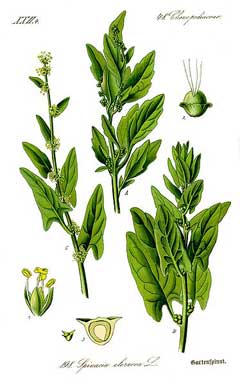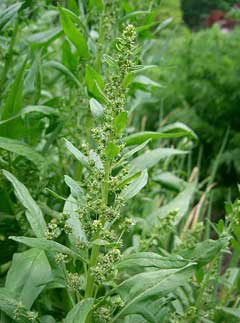 |
|
|
 |
| http://commons.wikimedia.org/wiki/User:KENPEI |
Translate this page:
Summary
Physical Characteristics

 Spinacia oleracea is a ANNUAL growing to 0.3 m (1ft) at a fast rate.
Spinacia oleracea is a ANNUAL growing to 0.3 m (1ft) at a fast rate.
See above for USDA hardiness. It is hardy to UK zone 5 and is not frost tender. It is in leaf all year, in flower from June to September. The species is dioecious (individual flowers are either male or female, but only one sex is to be found on any one plant so both male and female plants must be grown if seed is required). and is pollinated by Wind. The plant is not self-fertile.
Suitable for: light (sandy), medium (loamy) and heavy (clay) soils. Suitable pH: mildly acid, neutral and basic (mildly alkaline) soils. It can grow in semi-shade (light woodland) or no shade. It prefers moist soil.
UK Hardiness Map
US Hardiness Map
Synonyms
Chenopodium oleraceum. Obione stocksii. Spinacia spinosa. Moench.
Plant Habitats
Cultivated Beds;
Edible Uses
Edible Parts: Leaves Seed
Edible Uses: Colouring
Leaves - raw or cooked[1, 2, 16, 37, 132]. Tender young leaves can be added to salads, older leaves are used as greens or added to soups etc[183, 201]. The leaves contain oxalic acid (6 - 8% in young leaves, 23 - 27% in the cotyledons)[218], see the notes above on toxicity. A nutritional analysis of the leaves is available[218]. Seeds - raw or cooked. It can be sprouted and added to salads[183]. Chlorophyll extracted from the leaves is used as an edible green dye[142].
References More on Edible Uses
| Composition
|
| Figures in grams (g) or miligrams (mg) per 100g of food.
|
|
|
Leaves (Dry weight)
|
|
- 285 Calories per 100g
- Water : 0%
- Protein: 28g; Fat: 5.5g; Carbohydrate: 40g; Fibre: 8g; Ash: 23g;
- Minerals - Calcium: 800mg; Phosphorus: 415mg; Iron: 80mg; Magnesium: 0mg; Sodium: 650mg; Potassium: 4500mg; Zinc: 0mg;
- Vitamins - A: 50mg; Thiamine (B1): 0.7mg; Riboflavin (B2): 2mg; Niacin: 8mg; B6: 0mg; C: 600mg;
- Reference: [ 218]
- Notes: The values here are based on the median figures of those quoted in the report. Vitamin A figures are in milligrammes.
|
|
Medicinal Uses
Plants For A Future can not take any responsibility for any adverse effects from the use of plants. Always seek advice from a professional before using a plant medicinally.
Appetizer Carminative Febrifuge Hypoglycaemic Laxative Urinary
The plant is carminative and laxative[218]. In experiments it has been shown to have hypoglycaemic properties[218]. It has been used in the treatment of urinary calculi[240]. The leaves have been used in the treatment of febrile conditions, inflammation of the lungs and the bowels[240]. The seeds are laxative and cooling[240]. They have been used in the treatment of difficult breathing, inflammation of the liver and jaundice[240].
References More on Medicinal Uses
The Bookshop: Edible Plant Books
Our Latest books on Perennial Plants For Food Forests and Permaculture Gardens in paperback or digital formats.

Edible Tropical Plants
Food Forest Plants for Hotter Conditions: 250+ Plants For Tropical Food Forests & Permaculture Gardens.
More

Edible Temperate Plants
Plants for Your Food Forest: 500 Plants for Temperate Food Forests & Permaculture Gardens.
More

More Books
PFAF have eight books available in paperback and digital formats. Browse the shop for more information.
Shop Now
Other Uses
Dye
A yellow dye is obtained from the leaves[100].
Special Uses
Food Forest
References More on Other Uses
Cultivation details
Plants grow best and produce their heaviest crop of leaves on a nitrogen-rich soil[16, 37, 200]. They dislike very heavy or very light soils[37]. They also dislike acid soils, preferring a neutral to slightly alkaline soil[200]. Plants require plenty of moisture in the growing season, dry summers causing the plants to quickly run to seed[27]. Summer crops do best in light shade to encourage more leaf production before the plant goes to seed[27], winter crops require a warm dry sunny position[1, 27]. Young plants are hardy to about -9°c[200]. Spinach is often cultivated for its edible leaves, there are some named varieties[132, 183]. These varieties can be grouped into two main types as detailed below:- Forms with prickly seeds. These are the more primitive forms. Their leaves are more lobed and they are in general more cold tolerant and also more resistant of summer heat[264]. They were more often used to produce a crop in the winter[200, 264]. Forms with round seeds have been developed in cultivation, These have broader leaves, tend to be less cold hardy and were also more prone to bolt in hot weather[264]. They were used mainly for the summer crop[200]. Most new cultivars are of the round seeded variety and these have been developed to be more resistant to bolting in hot weather, more cold tolerant, to produce more leaves and also to be lower in calcium oxalate which causes bitterness and also has negative nutritional effects upon the body[264]. Some modern varieties have been developed that are low in oxalic acid. Edible leaves can be obtained all year round from successional sowings[200]. The summer varieties tend to run to seed fairly quickly, especially in hot dry summers and so you need to make successional sowings every few weeks if a constant supply is required. Winter varieties provide leaves for a longer period, though they soon run to seed when the weather warms up. Spinach grows well with strawberries[18, 20]. It also grows well with cabbages, onions, peas and celery[201]. A fast-growing plant, the summer crop can be interplanted between rows of slower growing plants such as Brussels sprouts. The spinach would have been harvested before the other crop needs the extra space[200]. Spinach is a bad companion for grapes and hyssop[201]. In garden design, as well as the above-ground architecture of a plant, root structure considerations help in choosing plants that work together for their optimal soil requirements including nutrients and water. The root pattern is fleshy. Thick or swollen - fibrous or tap root [2-1].
References Carbon Farming Information and Carbon Sequestration Information
Temperature Converter
Type a value in the Celsius field to convert the value to Fahrenheit:
Fahrenheit:
The PFAF Bookshop
Plants For A Future have a number of books available in paperback and digital form. Book titles include Edible Plants, Edible Perennials, Edible Trees,Edible Shrubs, Woodland Gardening, and Temperate Food Forest Plants. Our new book is Food Forest Plants For Hotter Conditions (Tropical and Sub-Tropical).
Shop Now
Plant Propagation
Seed - sow in situ from March to June for a summer crop. Make successional sowings, perhaps once a month, to ensure a continuity of supply. The seed germinates within about 2 weeks and the first leaves can be harvested about 6 weeks later. Seed is sown in situ during August and September for a winter crop.
Other Names
If available other names are mentioned here
Native Range
Coming Soon
Weed Potential
Right plant wrong place. We are currently updating this section.
Please note that a plant may be invasive in one area but may not in your area so it's worth checking.
Conservation Status
IUCN Red List of Threatened Plants Status :

Growth: S = slow M = medium F = fast. Soil: L = light (sandy) M = medium H = heavy (clay). pH: A = acid N = neutral B = basic (alkaline). Shade: F = full shade S = semi-shade N = no shade. Moisture: D = dry M = Moist We = wet Wa = water.
Now available:
Food Forest Plants for Mediterranean Conditions
350+ Perennial Plants For Mediterranean and Drier Food Forests and Permaculture Gardens.
[Paperback and eBook]
This is the third in Plants For A Future's series of plant guides for food forests tailored to
specific climate zones. Following volumes on temperate and tropical ecosystems, this book focuses
on species suited to Mediterranean conditions—regions with hot, dry summers and cool, wet winters,
often facing the added challenge of climate change.
Read More
Expert comment
Author
L.
Botanical References
200
Links / References
For a list of references used on this page please go here
Readers comment